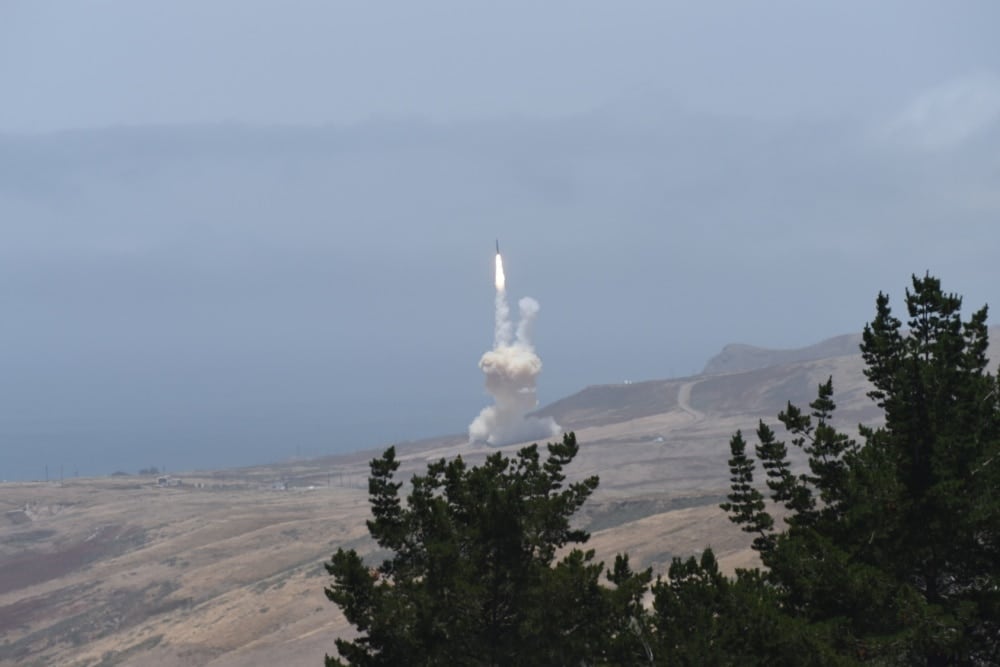WASHINGTON — The Missile Defense Agency is deeming the first salvo test of its homeland missile defense system against an intercontinental ballistic missile threat a success, according an agency statement.
The MDA conducted the test Monday. It last tested the Ground-Based Midcourse Defense System’s (GMD) Ground-Based Interceptors (GBI) against an ICBM target in May 2017. At that time, the MDA’s director said the agency was next shooting to conduct a more complex salvo test involving two GBIs against an ICBM, because firing off two GBIs against one target is more operationally realistic and important in proving out the effectiveness of the overall system.
RELATED

In the Monday test, the lead GBI destroyed the ICBM’s reentry vehicle “as it was designed to do,” according to the agency’s statement.
The trailing GBI “then looked at the resulting debris and remaining objects, and, not finding any other reentry vehicles, selected the next ‘most lethal object’ it could identify, and struck that, precisely as it was designed to do,” the statement adds.
The ICBM target was launched from the Reagan Test Site on Kwajalein Atoll in the Marshall Islands, which is over 4,000 miles away from the GBI interceptors buried in silos in the ground at Vandenberg Air Force Base, California.
“This was the first GBI salvo intercept of a complex, threat-representative ICBM target, and it was a critical milestone,” MDA Director Air Force Lt. Gen. Samuel Greaves said in the statement.
“The system worked exactly as it was designed to do, and the results of this test provide evidence of the practicable use of the salvo doctrine within missile defense,” he said. “The Ground-based Midcourse Defense system is vitally important to the defense of our homeland, and this test demonstrates that we have a capable, credible deterrent against a very real threat.”
Other systems involved in the test included space, ground and sea-based Ballistic Missile Defense System sensors that provided tracking acquisition and tracking data to the Command, Control, Battle Management and Communication (C2BMC) system, which is the brains of the global missile defense framework.
The GBI’s Exo-atmospheric Kill Vehicles, which had issues in the past, were successful in the test.
Trouble with the interceptor’s EKV, designed to destroy targets in high-speed collisions after separating from a booster rocket, plagued the program for years. Both 2010 and 2013 saw interceptor failures. During the July 2013 test, the kill vehicle failed to separate from the booster rocket.
The tide turned in June 2014 when the agency saw a successful intercept test bringing its success record to nine in 17 tests.
And the May 2017 test further signaled the problems with the EKV was a thing of the past. The salvo test adds more confidence in the performance of the EKV.
The MDA is funding a redesigned kill vehicle and is also developing a multi-object kill vehicle that can take out multiple threat targets.
The final GBI of the first 44 for the GMD system, which was designed to defend the homeland against possible ICBM threats from North Korea and Iran, was placed at Fort Greely, Alaska, in November 2017.
But the MDA is ramping up the number of GBIs to 64 in silos at two missile fields in Fort Greely after receiving special funding to do so in fiscal year 2019.
The MDA is requesting $1.2 billion in FY20 to continue the expansion of the GMD system and will equip 20 GBIs with its new RKV.
Jen Judson is an award-winning journalist covering land warfare for Defense News. She has also worked for Politico and Inside Defense. She holds a Master of Science degree in journalism from Boston University and a Bachelor of Arts degree from Kenyon College.







